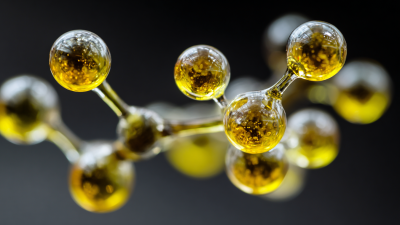Leave Your Message
As we approach 2025, the demand for Benzenedicarboxylic Acid continues to surge, driven by innovations and evolving market needs across various industries. Renowned expert Dr. Emily Carson, a leading chemist in organic compounds, states, "The versatility of Benzenedicarboxylic Acid in applications ranging from plastics to pharmaceuticals highlights its pivotal role in modern manufacturing." This compelling insight underlines the significant impact that this compound will have in shaping the future of numerous sectors.

In the coming years, the top five applications of Benzenedicarboxylic Acid are expected to experience remarkable growth, fueled by both technological advancements and an increasing awareness of sustainable practices. Industries are not only finding new and innovative uses for this compound but are also seeking to enhance its efficiency and application potential. With an emphasis on sustainability, Benzenedicarboxylic Acid is set to take center stage, showcasing its relevance in the development of eco-friendly materials and products.
As we delve deeper into the specific applications that are anticipated to dominate the market, it becomes evident that Benzenedicarboxylic Acid is more than just a chemical compound; it is a catalyst for innovation and a cornerstone for future advancements across multiple sectors.
In 2025, the demand for benzenedicarboxylic acid is poised for significant growth, driven by key market trends. One of the most significant trends influencing this demand is the increasing focus on sustainable and eco-friendly materials. As industries strive to minimize their environmental footprint, benzenedicarboxylic acid, known for its versatile applications in producing biodegradable plastics and resins, is becoming an essential ingredient in manufacturing processes aimed at sustainability.
Another trend propelling the demand is the rapid advancement of the automotive and electronics sectors, where benzenedicarboxylic acid is utilized in the production of high-performance polymers. These industries are increasingly adopting lightweight, durable materials to enhance efficiency and reduce emissions, pushing manufacturers to seek effective solutions that incorporate benzenedicarboxylic acid. Furthermore, innovations in textile applications, where it is used to create superior fibers and coatings, are also contributing to the heightened interest in this compound, showcasing its expanding relevance across various industrial applications.
Benzenedicarboxylic acid, particularly in its various forms, has gained prominence in the plastics industry due to its distinctive chemical properties and versatility. As manufacturers strive to meet the demands for stronger, more durable materials, the incorporation of benzenedicarboxylic acid into polymer formulations has emerged as a game-changer. Its ability to enhance thermal stability and reduce brittleness means that products can maintain integrity even under extreme conditions, addressing the needs of various applications from automotive components to consumer goods.
Moreover, ongoing innovation in the synthesis and application of benzenedicarboxylic acid is paving the way for its use in advanced bioplastics and recyclable materials. Researchers are exploring ways to integrate this compound into sustainable plastic alternatives, thus reducing reliance on fossil fuels and minimizing environmental impact. As the industry continues to evolve, the push toward eco-friendliness and circular economy principles is likely to drive further adoption of benzenedicarboxylic acid, making it an essential component for the future of plastic manufacturing.
The global market for benzenedicarboxylic acid, particularly in sustainable packaging solutions, is witnessing significant growth driven by increased environmental awareness and evolving consumer preferences. As the world shifts towards eco-friendly materials, the demand for bio-based and recyclable packaging is soaring. Reports indicate that the sustainable packaging market size will reach approximately $500 billion by 2028, reflecting a notable rise in the adoption of sustainable practices across various industries.

Benzenedicarboxylic acid, commonly known for its role in producing plasticizers and resins, is emerging as a vital component in the development of sustainable packaging materials. The versatility of this compound allows manufacturers to enhance the performance of packaging without compromising its eco-friendliness. Furthermore, with projections suggesting that the benzenedicarboxylic acid market will experience a steady growth trajectory, reaching an estimated value of $5 billion by 2027, companies are increasingly focusing on innovative applications that align with sustainability goals.
Amid these trends, industry stakeholders are exploring novel formulations and processes that incorporate benzenedicarboxylic acid into biodegradable packaging alternatives. This approach not only addresses the pressing issue of plastic waste but also meets stringent regulatory demands for sustainable materials. As market dynamics continue to evolve, the integration of benzenedicarboxylic acid in packaging solutions positions it as a key player in the pursuit of sustainable development.
Benzenedicarboxylic acid plays a pivotal role in the evolution of the automotive sector, primarily due to its applications in producing high-performance materials. For instance, the global market for 3-hydroxypropanoic acid was valued at $747.7 million in 2023 and is expected to grow significantly, reaching $1.521 billion by 2031, at a compound annual growth rate (CAGR) of 9.44%. This increase is driven by rising demand for sustainable alternatives in automotive manufacturing, where lightweight and durable materials are crucial for improving fuel efficiency and reducing carbon emissions.
Additionally, the market for 2,5-dihydroxybenzenecarboxylic acid esters is projected to expand from $0.15 million in 2022 to $0.25 million by 2030, reflecting a CAGR of 7.5% during the period. This growth aligns with the ongoing trend toward eco-friendly automotive materials, which are increasingly favored due to their ability to reduce the environmental impact of vehicle production. As car manufacturers strive to comply with global environmental standards, the integration of benzenedicarboxylic acid-based materials will likely become a key component in innovative automotive designs, driving market demand and fostering further advancements.
This chart illustrates the projected market demand for benzenedicarboxylic acid across the top five applications in 2025, highlighting its vital role in advancing the automotive sector and other industries through innovation.
The global market for benzenedicarboxylic acid is poised for significant growth, driven by market innovations and increasing demand across various industries. Projections suggest that the benzenedicarboxylic acid market will reach approximately $48.58 million by 2025, with an annual growth rate of 5.42%, potentially soaring to $74.1 million by 2033. This upward trajectory underscores the expanding applications of benzenedicarboxylic acid in crucial sectors such as plastics, additives, and barrier films.
One of the most noteworthy trends is the rising demand for specialized packaging materials, such as barrier films that protect products from environmental factors like moisture and oxygen. These films, produced from various polymers, including polyethylene and polyester, are increasingly utilized in food, pharmaceuticals, and electronics, reflecting the industry's commitment to enhancing product quality and shelf life. As the market for barrier films expands, the role of benzenedicarboxylic acid in developing innovative, high-performance materials will become increasingly vital, further strengthening its market presence and aligning with sustainability goals in packaging solutions.







